Hope & Yearning for Light
Posted October 2015 in Alternate Processes, Painters|Photographers, Publishing
Photography up to our modern day is by definition “Drawing with Light”, whereby the permanent recording of an object is achieved via electronic or chemical action. Simplistically this makes sense, but in order to make the outcome relevant and interesting enough to matter, especially in our visually overloaded present, practitioners to put it mildly need to include a bit of heart and soul into their efforts.
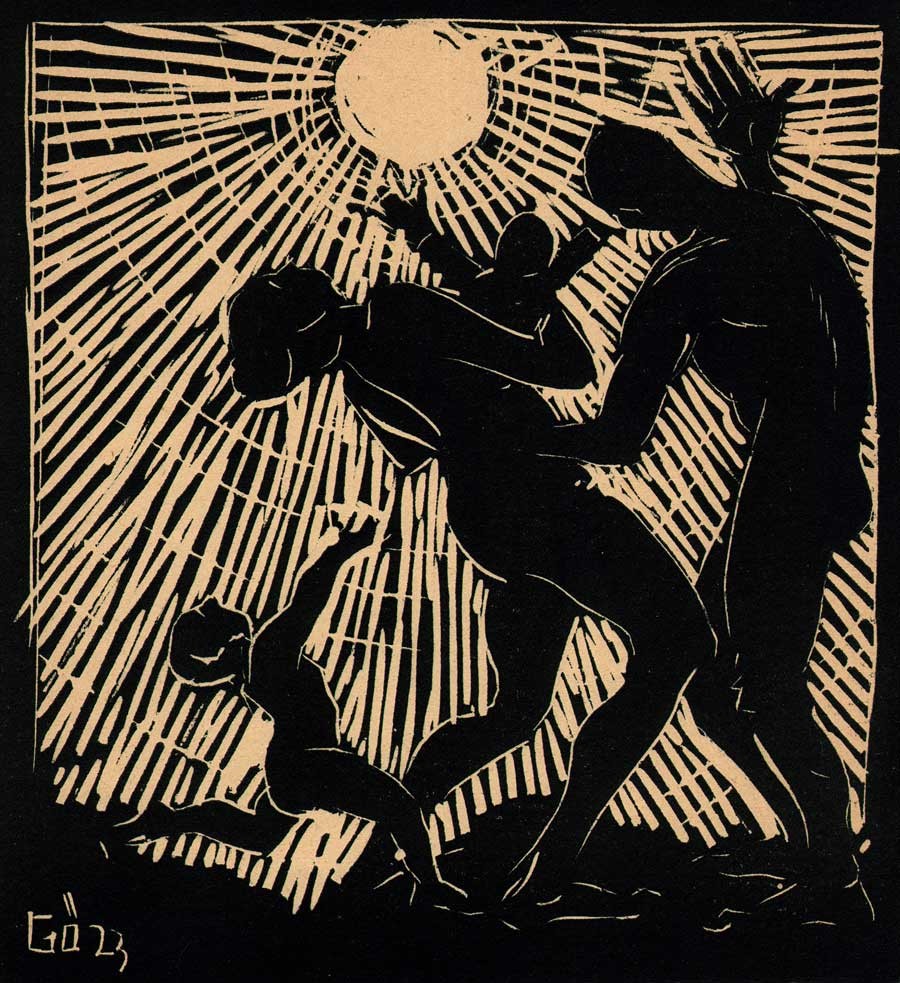 Detail: Linoleum cut: "Family in an Explosion of Light" : (20.5 x 18.8 cm impression | 28.9 x 25.0 cm paper) 1925 print by Emery Gondor, American (b. Hungary) : included in unpublished folio: "Sehnsucht nach Licht" (Yearning for Light) : "8 Original Linoleum schnitte von Emerich Göndör" (8 original Linoleum cuts by Emerich Göndör) from: PhotoSeed Archive
Detail: Linoleum cut: "Family in an Explosion of Light" : (20.5 x 18.8 cm impression | 28.9 x 25.0 cm paper) 1925 print by Emery Gondor, American (b. Hungary) : included in unpublished folio: "Sehnsucht nach Licht" (Yearning for Light) : "8 Original Linoleum schnitte von Emerich Göndör" (8 original Linoleum cuts by Emerich Göndör) from: PhotoSeed Archive
Emery Gondor (Emerich Göndör: 1896-1977) had these last two qualities in abundance. A Hungarian artist of prodigious talent who worked in multiple artistic disciplines including photography, the recent acquisition by this archive of some of his signed 1925 linocuts prove a teachable moment for why the manipulations of light and dark in another medium are instructive for creative souls in the present.
Some background, including the reality and history of turbulence in early 20th Century Europe, are critical to our understanding in how artists like Gondor could not be defeated by hatred which destroyed millions of lives and split apart society’s fabric there.
Indeed, his empathy for those shattered lives were taken to heart in the aftermath of his three and a half year service as a soldier in World War I which changed his life forever. Combined with his interest in progressive art education for children discovered in the early 1920’s while attending Vienna’s Academy of Industrial Arts and his work with emotionally disturbed children at the University Clinic there gave him an outlet and purpose for artistic expression, and would culminate towards the end of his career in the 1960’s as director of the art program at the Institute for Mental Retardation at New York Medical College (today : Westchester Institute for Human Development) after earning a degree in Clinical Psychology from New York State University. (1.)
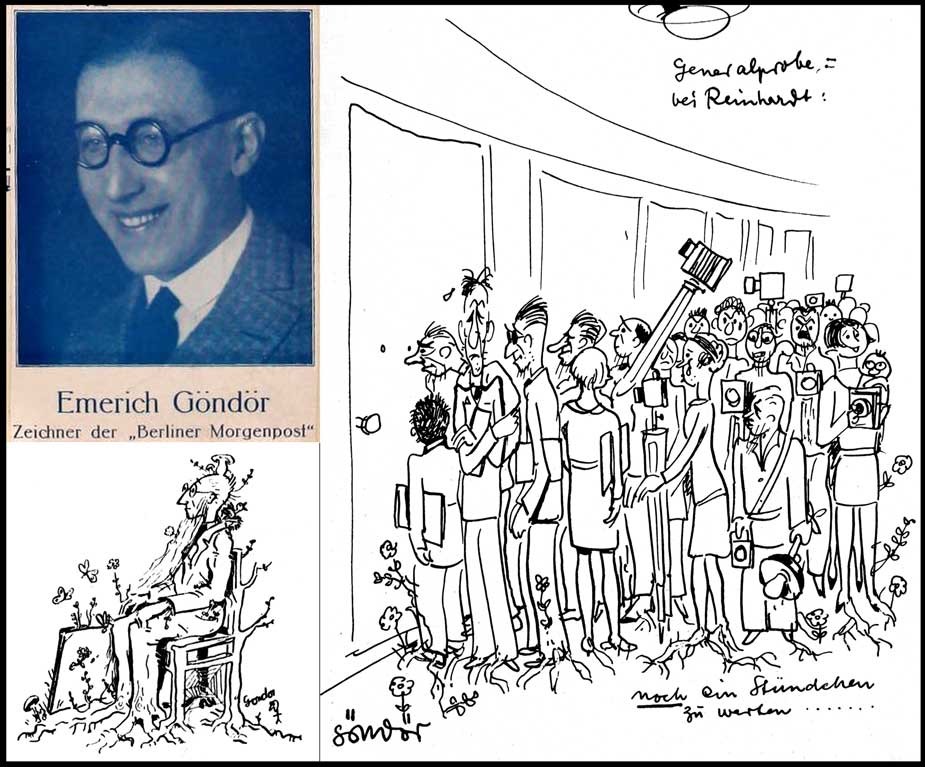 Upper left: 1929 photograph of Emery Gondor when employed as artist for Berliner Morgenpost newspaper in Germany. Bottom left: humorous caricature from early 1920's shows the artist seated with legs growing into the ground like roots. His cartoon poking fun at an interminable wait to see an editor at Berlin's Ullstein Verlag publishing house earned him a twelve year career there, where he excelled in multiple artistic disciplines including press photography with theatre subjects a specialty. Right: cartoon titled "Generalprobe bei Reinhardt" (Rehearsal at the Reinhardt) shows the artist (first figure standing at left wearing glasses) along with other members of the press waiting outside the Deutsches Theater to be let in for a press review. The drawing appeared in the May, 1930 issue of Blätter Des Deutschen Theaters. (Journal of the German Theater of Berlin) Surreally, the first name in a contributing, alphabetical list of well known actors, artists, writers and composers for the issue was Benno von Arent, an art director and production designer who became a ranking member of the Nazi SS responsible for art, theatres and cinema for Hitler. sources: portrait and theatre cartoon: Series V: Clippings and Scrapbooks, 1909-1935: Emery and Bertalan Gondor Collection; Leo Baeck Institute; lower left: illustration from graphic arts journal PM, 1936: New York: "Mr. Gondor comes to America".
Upper left: 1929 photograph of Emery Gondor when employed as artist for Berliner Morgenpost newspaper in Germany. Bottom left: humorous caricature from early 1920's shows the artist seated with legs growing into the ground like roots. His cartoon poking fun at an interminable wait to see an editor at Berlin's Ullstein Verlag publishing house earned him a twelve year career there, where he excelled in multiple artistic disciplines including press photography with theatre subjects a specialty. Right: cartoon titled "Generalprobe bei Reinhardt" (Rehearsal at the Reinhardt) shows the artist (first figure standing at left wearing glasses) along with other members of the press waiting outside the Deutsches Theater to be let in for a press review. The drawing appeared in the May, 1930 issue of Blätter Des Deutschen Theaters. (Journal of the German Theater of Berlin) Surreally, the first name in a contributing, alphabetical list of well known actors, artists, writers and composers for the issue was Benno von Arent, an art director and production designer who became a ranking member of the Nazi SS responsible for art, theatres and cinema for Hitler. sources: portrait and theatre cartoon: Series V: Clippings and Scrapbooks, 1909-1935: Emery and Bertalan Gondor Collection; Leo Baeck Institute; lower left: illustration from graphic arts journal PM, 1936: New York: "Mr. Gondor comes to America".
In an 1936 artist profile published in the graphic arts journal PM Magazine soon after his immigration to the United States from Europe, Emery Gondor writes:
”But my real interest and love is children. I illustrated many children’s books for the “Union Verlag” Stuttgart, the biggest children’s publishing house, and other youth-publications.” …I made up many hundreds of games for children, puzzles for adults, comic strips. I exhibited again and wrote many articles about humorous observations of children. I always received hundreds of fan letters from my children friends.” (2.)
The Germinal Circle
As a young artist living and just getting by in Vienna after WWI, Gondor did not shy away from progressive ideas as well as the opportunity to sell his original artwork while promoting himself. Traveling to London in late 1923, he did live caricature sketches of poems read aloud by their authors on November 5th and 23rd as an invited guest of the Germinal Circle. Organized by the Italian anarchist Silvio Corio and his lover Sylvia Pankhurst, a like-minded British writer whose mother Emmeline Pankhurst was the leader of the British suffragette movement, the circle was an artistic and literary salon for their short-lived political and cultural monthly magazine Germinal founded the same year. (3.)
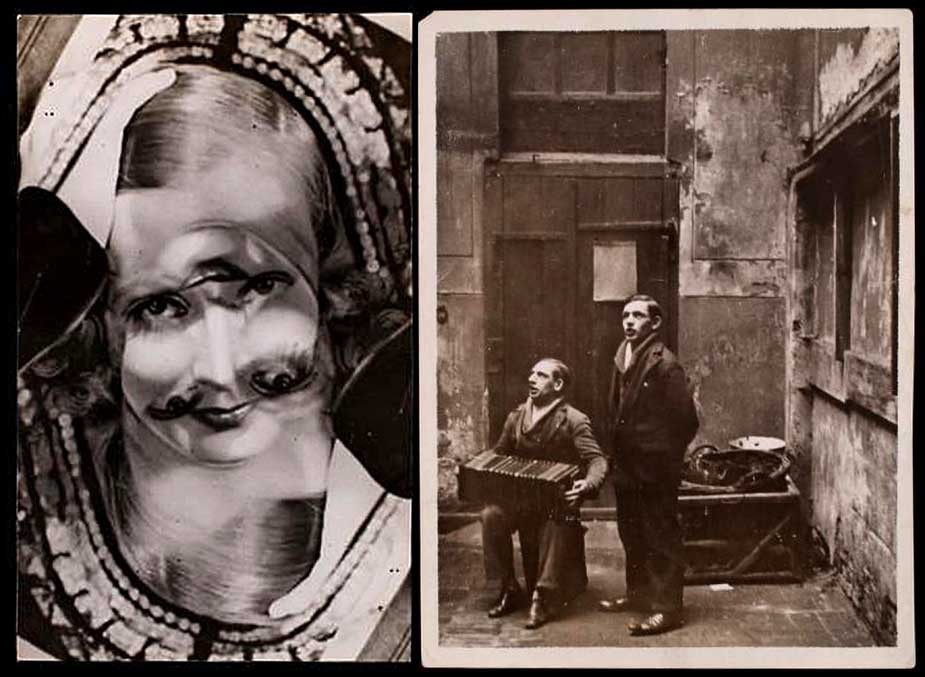 Although better known as an artist, Emery Gondor was an accomplished photographer whose work appeared in some of the largest European newspapers (principally German) from the mid 1920's into the 1930's. Work contained in his archive at the Leo Baeck Institute in New York City shows a talent equally adept at documentary in addition to staged subject matter including theatrical. Hartmuth Merleker, his former editor at the Ullstein newspapers Tempo and Berliner Montagspost, describes Gondor as not only an artist but a press photographer for the publications between 1929-1933. After learning his grandfather was a lithographer and father an engraver, an excerpt from his 1936 profile by the artist states further on the subject of photography: "I have always had an interest in the problems of reproduction technique. I learned press-photography too. In a short time I learned all the chemical and technical details. I worked one year for the "B.Z. am Mittag," the quickest German daily paper, as press photographer, and in accordance with my plan Ullstein built eight dark rooms for their daily paper photo service." Photographs by Gondor shown here: left: photomontage likely from the late 1920's of a theatrical subject. It likely appeared in one of Ullstein's German publications. Right: documentary subject of street musicians from early 1930's Europe or possibly 1940's New York; with Gondor's red-ink New York City stamp on print verso. Sources for both: Emery I. Gondor Collection; AR 25397; Box 2; Folder #49; Leo Baeck Institute.
Although better known as an artist, Emery Gondor was an accomplished photographer whose work appeared in some of the largest European newspapers (principally German) from the mid 1920's into the 1930's. Work contained in his archive at the Leo Baeck Institute in New York City shows a talent equally adept at documentary in addition to staged subject matter including theatrical. Hartmuth Merleker, his former editor at the Ullstein newspapers Tempo and Berliner Montagspost, describes Gondor as not only an artist but a press photographer for the publications between 1929-1933. After learning his grandfather was a lithographer and father an engraver, an excerpt from his 1936 profile by the artist states further on the subject of photography: "I have always had an interest in the problems of reproduction technique. I learned press-photography too. In a short time I learned all the chemical and technical details. I worked one year for the "B.Z. am Mittag," the quickest German daily paper, as press photographer, and in accordance with my plan Ullstein built eight dark rooms for their daily paper photo service." Photographs by Gondor shown here: left: photomontage likely from the late 1920's of a theatrical subject. It likely appeared in one of Ullstein's German publications. Right: documentary subject of street musicians from early 1930's Europe or possibly 1940's New York; with Gondor's red-ink New York City stamp on print verso. Sources for both: Emery I. Gondor Collection; AR 25397; Box 2; Folder #49; Leo Baeck Institute.
Several of Gondor’s original linocuts, including one incorporated into an advertisement showing a figure with outstretched arms standing next to a grouping of over-sized flowers facing emanating sun rays were reproduced as part of promotional literature in Germinal. The artist from this period is described in a typescript document held with the reproduction in the library of the Leo Baeck Institute in New York City:
The Germinal Circle has pleasure in introducing the work of Emerich Gondor, a young Hungarian artist, who has not previously exhibited in this country. A rapid caricaturist and cartoonist, he works with equal facility through lithography, wood-cuts, lino-cuts and many other mediums. (4.)
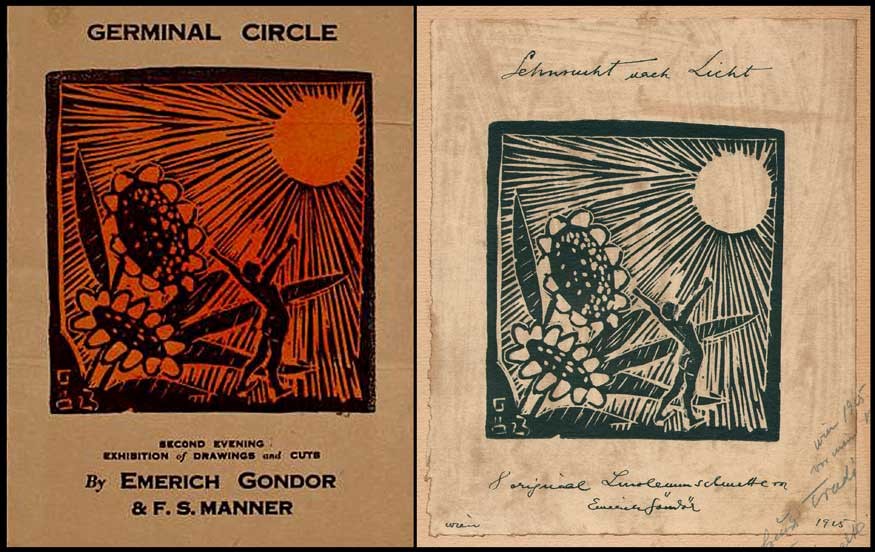 Left: detail: 1923 linoleum cut in two colors by Emery Gondor used as program advertisement for the Germinal Circle art salon's "Second Evening Exhibition of Drawings and Cuts which took place at the Ashburton Restaurant in London on November 28, 1923. source: Emery and Bertalan Gondor Collection; Leo Baeck Institute. Right: detail: same illustration with impression pulled in 1925 (20.5 x 18.8 cm ) used as cover maquette for Gondor's unpublished folio: "Sehnsucht nach Licht" (Yearning for Light) : "8 Original Linoleum schnitte von Emerich Göndör" (8 original Linoleum cuts by Emerich Göndör) from: PhotoSeed Archive
Left: detail: 1923 linoleum cut in two colors by Emery Gondor used as program advertisement for the Germinal Circle art salon's "Second Evening Exhibition of Drawings and Cuts which took place at the Ashburton Restaurant in London on November 28, 1923. source: Emery and Bertalan Gondor Collection; Leo Baeck Institute. Right: detail: same illustration with impression pulled in 1925 (20.5 x 18.8 cm ) used as cover maquette for Gondor's unpublished folio: "Sehnsucht nach Licht" (Yearning for Light) : "8 Original Linoleum schnitte von Emerich Göndör" (8 original Linoleum cuts by Emerich Göndör) from: PhotoSeed Archive
Sehnsucht nach Licht: Yearning for Light
Emery Gondor’s style in his surviving linoleum cuts from the early 1920’s were certainly influenced by the German Expressionists, and of the heartbreak and for many, hope in the aftermath of the first World War. With emotional joy and pathos rendered in exaggerated strokes of light and dark, the symbolism of the sun and its streaming rays reaching out to embrace humankind is duly represented by his hopeful thematic subjects among others including a family, baby, old man, a blind man, and prisoner locked in a cell as well as the artist himself in signed impressions, several of which are seen here.
The original 1925 cover maquette linoleum cut by Gondor, featuring the aforementioned figure with outstretched arms, has the hopeful title Sehnsucht nach Licht . (Yearning for Light) Featuring eight original linoleum cuts with the themes outlined above, the work is not believed to have been published other than several copies, although seven of the eight plates as well as the maquette can be found here on this website as well as the full compliment and other examples of Gondor’s artwork from his career at the Baeck Institute online site.
 Detail: Linoleum cut: "Old Prisoner gazing at the Light" : (20.0 x 18.7 cm impression | 28.5 x 25.0 cm paper) 1925 print by Emery Gondor, American (b. Hungary) : included in unpublished folio: "Sehnsucht nach Licht" (Yearning for Light) : "8 Original Linoleum schnitte von Emerich Göndör" (8 original Linoleum cuts by Emerich Göndör) from: PhotoSeed Archive
Detail: Linoleum cut: "Old Prisoner gazing at the Light" : (20.0 x 18.7 cm impression | 28.5 x 25.0 cm paper) 1925 print by Emery Gondor, American (b. Hungary) : included in unpublished folio: "Sehnsucht nach Licht" (Yearning for Light) : "8 Original Linoleum schnitte von Emerich Göndör" (8 original Linoleum cuts by Emerich Göndör) from: PhotoSeed Archive
Sobering, but Necessary
Eventually, Gondor’s talents paid off. Besides honed artistic chops, abundant energy, charisma and a sunny disposition as evidenced by his ever-present smile seen in surviving photographs, he attained the title of Art Director for the Ullstein Verlag publishing house of Berlin, the largest concern in Europe. But then in 1933, the Nazis came, he wrote in the 1936 PM profile, and everything changed and was lost. In September of 1935, Gondor’s former editor Hartmuth Merleker of the Ullstein newspapers Tempo and Berliner Montagspost wrote a glowing review of his talents which spoke of this fine character giving him the needed credibility in the eyes of German authorities and the right to emigrate for his new life in America:
”He worked mainly as comic and propaganda artist and as a theater photographer and absolved himself to everyone’s satisfaction. He tactfully refrained from attending any non-artistic, non-photographic activities, and as a Hungarian citizen was never known to abuse the right to hospitality he enjoyed in Germany to Germany’s disadvantage.” (5.)
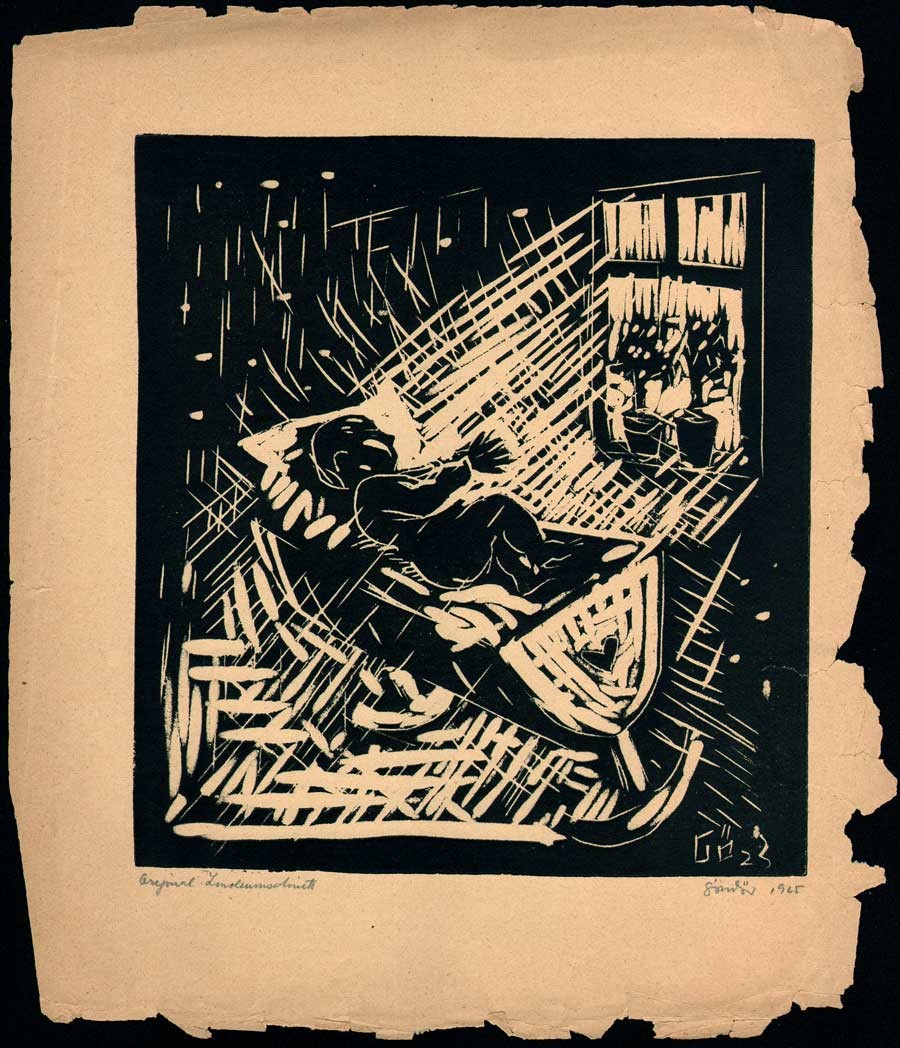 Linoleum cut: "Child in an Explosion of Light" : (20.5 x 18.8 cm impression | 28.9 x 24.8 paper) 1925 print by Emery Gondor, American (b. Hungary) : included in unpublished folio: "Sehnsucht nach Licht" (Yearning for Light) : "8 Original Linoleum schnitte von Emerich Göndör" (8 original Linoleum cuts by Emerich Göndör) from: PhotoSeed Archive
Linoleum cut: "Child in an Explosion of Light" : (20.5 x 18.8 cm impression | 28.9 x 24.8 paper) 1925 print by Emery Gondor, American (b. Hungary) : included in unpublished folio: "Sehnsucht nach Licht" (Yearning for Light) : "8 Original Linoleum schnitte von Emerich Göndör" (8 original Linoleum cuts by Emerich Göndör) from: PhotoSeed Archive
Sobering in hindsight of course. What true artist in their own mind could “tactfully refrain from “any non-artistic, non-photographic activities” during the course of his or her work? Fortunately for us, Emery Gondor had a bit of luck going his way as well, with earlier examples of his artistic legacy preserved here for posterity and later career achievements benefiting those children he helped and inspired a testament to the abundant light emanating from his own oversized heart and soul.
David Spencer- October, 2015
Notes:
1. background: Emery Gondor: Biographical/Historical Note: from: Emery I. Gondor Collection: Leo Baeck Institute online archive accessed Oct. 2015. In Gondor’s 1954 application to publisher Doubleday for his book Art and Play Therapy published the same year, it stated he “is a sensitive clinician of long and varied experience. Early in his career he had no intention of becoming a psychologist or psychotherapist, but began as an artist and teacher of art after attending the Royal Hungarian University and receiving his diplomas from the Federal Academy of Art in Budapest. As a young art teacher, however, he was faced with the misery of children who suffered tremendously during and after the first World War, and felt that he had to understand more about their problems in order to be able to help them. Thus began his interest in the study of psychology.”
2. PM: 1936: Mr. Gondor comes to America: p. 7
3. Germinal, a quarto monthly ran for two issues in July, 1923 and one other unknown issue published in 1924. “This illustrated journal published fiction by Gorky, drama by Ernest Toller, poetry by Alexander Blok, by Anna Akhmatova and by Pankhurst.” see: Morag Shiach: Modernism, Labour and Selfhood in British Literature and Culture, 1890-1930: Sylvia Pankhurst: labour and representation: 2004: p. 103
4. see: The Germinal Circle: Leo Baeck Institute Archives: New York: Folder 1/16: Call number AR 25397
5. translated, hand-written copy of Sept 7, 1935 letter by editor Hartmuth Merleker contained in Leo Baeck Institute online archives.
This entry was posted on Thursday, October 22nd, 2015 at 8:27pm and is filed under Alternate Processes, Painters|Photographers, Publishing. You can follow any responses to this entry through the RSS 2.0 feed.